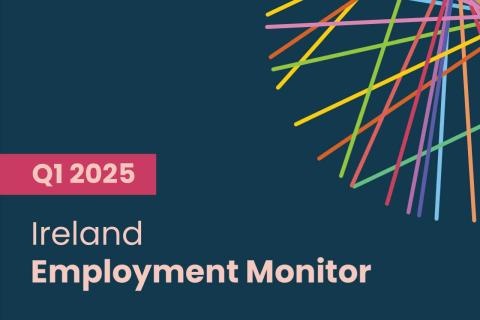What the Data Says: Is Hybrid Work the Key to Employee Satisfaction?

Hybrid working; essential for a better work-life balance, or productivity inhibitor?
Everybody has differing views of the hybrid work model, but there’s one thing that’s undeniable: It’s everywhere, and it doesn’t look like it’s going away…As companies embrace the newer work trends, understanding what employees want versus what employers expect is critical to designing a sustainable workplace model.
Morgan McKinley recently researched to gather insights about various hiring and workplace trends by surveying over 2751 professionals and 530 employers/hiring managers globally.
- 45% prefer working 1-2 days in the office per week.
- 30% prefer 3-4 days in the office.
- Only 9% want to be in the office full-time.
Going further into the details of the study and analysing the working preferences of professionals, it was quite evident that those working in a hybrid manner are the most content with their current work patterns. The majority of hybrid workers, 88% to be precise, would prefer to continue working in the same model, suggesting that this arrangement suits.
Professionals who are currently working full-time onsite, however, seem to be less happy with their work schedule. Only 30% of them would prefer to work full-time onsite, while the majority (68%) would prefer a hybrid work arrangement.

A Growing Mismatch: Employers vs. Employees on Hybrid Work
While professionals highly favour hybrid working, employers aren’t always as eager to embrace it. Our research found that 24% of companies now require employees to spend more time in the office than last year.
The disconnect between employee preferences and employer expectations has profound implications.
- Talent attraction and retention: Companies that fail to offer flexibility risk losing top talent.
- Turnover risks: Employees who are denied hybrid options are more likely to actively seek new opportunities.
- Job satisfaction and engagement: Lack of flexibility can lead to disengagement and higher attrition rates.

It's quite interesting to note that, compared to hybrid employees (46%), fully remote employees have a higher rate (58%) of actively seeking out new opportunities. Spending some time at the office may be beneficial for strengthening the bonds between employees, their employer, and others in the workplace.
It is imperative that organisations take this into account when outlining work arrangements - it’s key to complement employee choices and promote job satisfaction.
Hybrid Work and Seniority: Is There a Fair Balance?
Our data reveals a trend in flexibility by seniority level:
- Entry-level employees are most likely to be onsite full-time (49%).
- Managers and senior professionals have significantly more flexibility (28% and 23% onsite, respectively).
However, this approach may not be the most effective. If junior employees are expected to be onsite to learn and network, but senior leaders are working remotely, mentorship opportunities and knowledge transfer could be compromised.
Employers should strike a balance between supporting early-career employees while ensuring that experienced leaders are accessible for guidance and development.
There is no ‘one size fits all’ approach to hybrid working
Hybrid work arrangements are unquestionably in demand, but it's important to recognise that there is no one-size-fits-all solution. Work patterns vary significantly by industry. Some sectors naturally lend themselves to remote and hybrid work, while others require an onsite presence.
For example, industries such as Technology, Projects & Change, and Sales & Marketing are more conducive to working in hybrid patterns. A large portion of the tasks in these fields do not necessarily require face-to-face communication. According to our data, just 24% of professionals in Sales & Marketing, 19% of professionals in Technology, and 11% of professionals in Projects & Change work on-site five days a week.

Sectors like Life Sciences, Engineering, and Supply Chain require more onsite work, whereas Technology, Projects & Change, and Marketing roles can function effectively in hybrid environments.
Employers should assess their specific industry needs before defining rigid work policies.
These findings highlight the unique requirements of different industries and roles. It is down to the employer and managers to ensure their teams and individual employees work in patterns that mean they can perform to their best abilities.
Employee Satisfaction Based on Work Model
Workplace flexibility directly impacts job security, engagement, and satisfaction.
- 42% of hiring managers say that flexible work patterns are key to attracting and retaining top talent.
- 74% of employers who lost staff in the last six months cite lack of flexibility and salary concerns as top reasons.
When examining how satisfied employees are with the benefits they receive, which include flexibility for remote and hybrid workers, it's noteworthy that those who are onsite full-time express the least satisfaction. Regarding their benefits packages, 26% of onsite professionals said they were "dissatisfied" or "highly dissatisfied". To compare, just 18% of hybrid workers and 19% of fully remote workers expressed discontent with the benefits they receive.
Professionals with a hybrid work pattern report feeling the most secure in their current jobs (51%), and they also report the lowest levels of insecurity (29%). However, the largest number of insecure respondents were remote workers (38%), which could be attributed to fears about them becoming "out of sight, out of mind."

Employers seeking to alleviate these worries should take extra caution when communicating with employees who are not as physically present.
This shows that hybrid working is the best approach for optimum satisfaction and security - having the blend of in-person interaction, whilst benefiting from flexibility in working patterns.
An opportunity for some to shine
Hybrid working presents an invaluable opportunity to small to medium-sized companies to get ahead in the search for top talent. Smaller organisations can be more fluid in the flexibility they offer compared to the more prominent companies with more rigid structures, providing the kind of adaptability and levels of freedom that many job seekers look for in an employer.
If they can't match the big players in salary, a flexible work schedule and a more agile environment can be significant pulling factors for talent.

The challenges businesses are grappling with
There are a number of reasons why companies are calling back their employees back to office, including the most prominent being ‘to improve collaboration between employees’, followed by ‘to reinforce culture’ and ‘to improve performance’. This shows that while hybrid working has its share of benefits, it's not without challenges too.
Communication can be a tough nut to crack in a hybrid environment. Keeping teams connected, whether they're at home or in the office, requires a thoughtful approach. With strong communication, you can ensure your teams keep their productivity levels high.
Then there's employee wellbeing. While hybrid work can improve work-life balance, it can also lead to feelings of isolation and burnout. Businesses must proactively address potential wellbeing issues and provide support accordingly.
Maintaining a strong company culture and fostering team cohesion can be a significant challenge in a dispersed workforce. It calls for creativity in team-building exercises and regular check-ins to maintain that all important human connection between team members.
Some other organisational challenges include:
- Legal and Compliance issues: Navigating labour laws, tax regulations, and data privacy concerns can be complex when employees work across different locations and jurisdictions.
- Remote onboarding challenges for entry-level roles: Remote onboarding can be a real puzzle, especially for entry-level positions that often thrive on hands-on learning from colleagues. Without the in-person experience, the natural flow of knowledge transfer can be disrupted.
- Inconsistent work station set ups: Not everyone has equal access to the necessary technology or facilities for remote work. An inadequate place to work, and poor internet connectivity can hamper productivity.
- Security risks: Remote work can expose businesses to increased cybersecurity threats, demanding the implementation of robust security measures and employee training to protect sensitive data.
- Inclusivity and Equality: Companies must ensure that hybrid working is inclusive and doesn't inadvertently disadvantage certain groups of employees.
- Transitioning to a hybrid model: The transition from a traditional office-based model to a hybrid one can be challenging, necessitating changes in policies, procedures, and company culture.
Companies must adapt by addressing technological disparities, fostering communication, prioritising employee wellbeing, and ensuring compliance with regulations.
For hybrid new starters, regular video meetings, virtual mentorship programs, structured training, and clear communication channels ensure that even in a remote setting, they get the support needed to learn and grow.
Are managers the superstars of the hybrid work era?
With great flexibility comes the need for a different approach to workforce monitoring and evolving managerial responsibilities. Employers are embracing new technologies and strategies to ensure remote teams remain productive. This includes using productivity-tracking tools, maintaining open lines of communication and, most importantly, building trust.

In the world of remote work, data plays a pivotal role. When you can't physically see what your team is up to, tracking progress and having solid reporting mechanisms become even more critical. Trustworthy data trails are like a roadmap, guiding managers to understand productivity and performance levels.
“It's not just about keeping tabs; it's about keeping work on course and achieving your goals.”
In a remote setting, data acts as the bridge that connects managers with their teams, ensures accountability and transparency, and contributes to the overall success of the business.

Managers play a pivotal role in this equation; they must now focus on outcomes rather than hours logged. Ensuring teams stay engaged and connected, making a conscious effort to foster a strong company culture, and addressing any mental health concerns are all part of the new normal.
Designing a Hybrid Work Model That Works for Everyone
Flexibility is at the core of this new working model, but it's not without its challenges. If everyone understands what their role is in making this new system work well (and what happens if they don't), then everyone wins. The key to success is getting employers and employees on the same page.
With the right strategies and a forward-thinking approach, businesses can thrive in the era of hybrid work, creating a more inclusive, productive, and resilient workforce.














